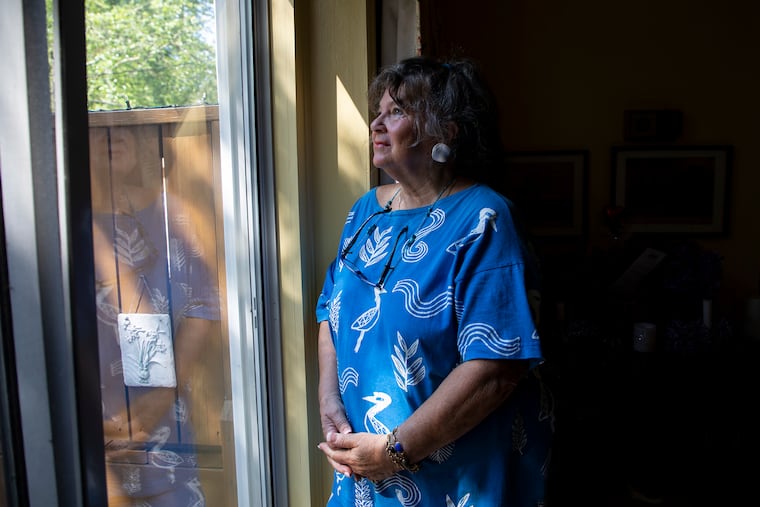Medical mystery: She thought her shoulder pain came from moving furniture
At Lankenau Medical Center, an emergency-room doctor asked a key question: Had she been traveling?

For more than a week, Vicky Benedict Farber felt a nagging pain in her right shoulder.
The Narberth resident figured that she had pulled or torn some muscles in her rotator cuff, as she recently had helped her aunt move some heavy furniture.
“Go to the doctor!” her aunt urged her.
“Nah,” said Farber, who was 66 at the time. She thought it was no big deal, and just popped a few ibuprofen every day.
But Farber also felt some pain at the bottom of her right rib cage. And before long, she started to feel unusually tired, as if she were moving in slow motion.
“I felt like I was walking through Vaseline,” she said.
She called her doctor’s office on a Monday morning in June 2014, and the nurse said they were booked. But upon hearing that Farber had rib pain — a possible sign of heart trouble — the nurse ordered her to go straight to an emergency room.
Farber drove herself to Lankenau Medical Center, where physicians ordered blood tests and an electrocardiogram (EKG) to see whether she had experienced a heart attack. But all seemed normal.
They also ordered a chest X-ray, which would indicate whether she were suffering from pneumonia, or perhaps a broken rib. It was neither.
Physician Alvin Wang asked her a fateful question:
“Have you been traveling?”
Solution
Alvin Wang was on the right track.
Vicky Benedict Farber’s furniture-moving had taken place in Hawaii, at two condominiums that her aunt owned. She had flown first to Los Angeles for a few days, then on to Hawaii, then back to L.A. before returning to Philadelphia. The round trip was close to 10,000 miles.
Wang and his Main Line Health colleagues, hospitalists Pamela Cines and Vincent Pestritto, suspected Farber might have suffered from a condition called deep vein thrombosis — blood clots in the legs — and that those clots had broken off and traveled to her lungs. That condition, called a pulmonary embolism, can be dangerous if not treated.
Clots can develop in the legs of anyone who is inactive for a long period of time, such as a patient recovering from surgery, or even someone who sits on the floor playing video games for hours. Long airplane flights can be especially risky, as passengers tend to become dehydrated, meaning their blood is thicker and may be more prone to clots.
These clots can cause a throbbing or painful sensation in the legs, though not always, Pestritto said. (He was not the chief physician involved in Farber’s care, but with her permission, he agreed to discuss the case because Wang has since left to work in the Jefferson Health system.)
“It’s such an individualized thing,” Pestritto said. “Some folks feel pain. Some folks see swelling. Some have swelling, redness, and pain. And some folks never know anything at all is wrong in their legs.”
Farber felt no pain in her legs, though she had experienced some swelling before her ER visit. Doctors and nurses also noted that she had suffered some shortness of breath.
A CT scan told the story. Multiple blood clots had lodged in both lungs, most of them in the right one.
She was immediately given intravenous and oral blood-thinning medication, preventing the clots from growing larger so her body could start to break them down.
An ultrasound detected no clots in her legs, yet it seemed clear that was the source of the clots in her lungs. Sometimes part of a clot in the leg will break off and travel to the lungs, leaving a piece behind, while on other occasions the entire clot breaks off, Pestritto said.
If untreated, a pulmonary embolism can become life-threatening. In the worst-case scenario, it can lead to dangerously low blood pressure, respiratory failure, and even cardiac arrest. When not diagnosed and treated, the condition is fatal up to one-third of the time, according to the Mayo Clinic.
Farber insisted on seeing the scan that revealed the blood clots.
“They were pencil-eraser sized,” she recalled.
She was admitted to Lankenau that Monday, and by the next day, she felt much better.
“I was champing at the bit,” said Farber, a former drug-store supervisor who now volunteers for a hospice agency. “I wanted to get out of there.”
Physicians finally cleared her to leave the following day, giving her a prescription for oral blood-thinning medication to take for six months at home. Her primary-care physician later told her she had “dodged a bullet,” she said.
Though the episode occurred five years ago, Farber, now 71, described it as though it happened yesterday. She contacted The Inquirer to relate her experience after reading about a similar case in the news, hoping to raise awareness.
These days, when she flies, Farber wears compression stockings and also keeps active.
“I try to get up and walk around,” she said. “I drive the flight attendants crazy.”
Another option is for passengers to flex their ankles periodically. The key is to not remain motionless for hours on end.
The lower limbs, and the blood inside them, need to move.